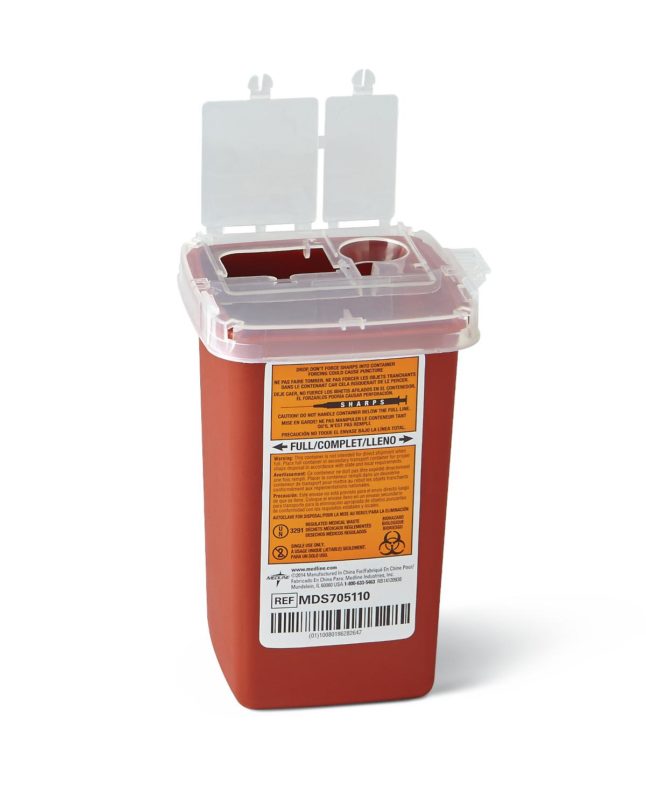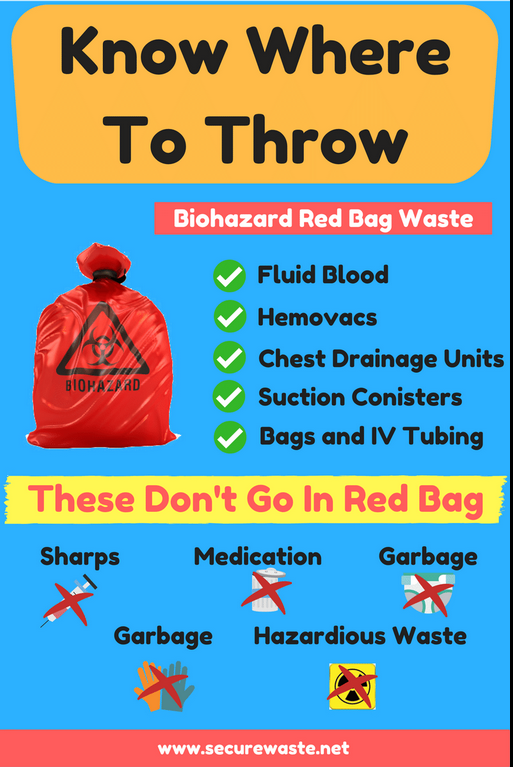Medical Waste Removal Quality: Elevating Security Specifications in Your Facility
Medical Waste Removal Quality: Elevating Security Specifications in Your Facility
Blog Article
Minimize Expenses and Take Full Advantage Of Security: Effective Medical Garbage Disposal Strategies
Effective medical garbage disposal approaches are critical for medical care centers to lessen expenses and optimize safety. With the expanding worry for environmental sustainability and the boosting variety of guidelines surrounding waste monitoring, it is imperative for medical care companies to adopt certified and effective methods. By implementing correct segregation and categorization, effective product packaging and labeling, secure transportation and handling, effective therapy and disposal methods, and conformity with regulative standards, health care facilities can make sure the accountable and safe administration of medical waste. In this conversation, we will explore each of these methods in detail, giving insights and sensible suggestions for medical care professionals to maximize their waste disposal procedures.

Proper Segregation and Categorization
Appropriate segregation and categorization are vital parts of effective medical waste disposal techniques, guaranteeing the security of health care employees, the public, and the setting - medical waste removal services. medical waste disposal services with WasteX. By dividing various kinds of clinical waste at the point of generation, healthcare centers can reduce the risk of cross-contamination and possible damage to individuals and environments
Among the essential consider appropriate segregation is the recognition and classification of clinical waste. This entails classifying waste into various groups, such as contagious, hazardous, contaminated, or pharmaceutical waste. Each category calls for details handling, storage space, and disposal methods to avoid any type of damaging impacts on human wellness and the environment.
In addition, proper segregation likewise includes making use of color-coded containers and labels to plainly identify and separate the various types of clinical waste. This helps health care employees and waste management workers to conveniently recognize and manage the waste suitably. Red containers may be made use of for transmittable waste, while yellow containers may be assigned for unsafe waste.
In addition to segregation, appropriate classification also involves the right product packaging and control of medical waste. This guarantees that waste is safely saved and transported without positioning any type of threats to people or the atmosphere. Making use of puncture-resistant and watertight containers, as well as correctly sealing and identifying them, assists to stop any unexpected direct exposure or launch of harmful compounds.
Reliable Product Packaging and Classifying
Reliable product packaging and labeling play a crucial function in making sure the safe and effective disposal of medical waste. Correct product packaging is crucial to avoid leakage, breakage, or spillage throughout transport and handling. It assists to lessen the danger of contamination and safeguards healthcare workers, waste management employees, and the setting from prospective risks.
Medical waste should be packaged in tough and watertight containers that are immune to pierce and breakage. These containers should be effectively secured to stop any leak. Additionally, the product packaging must be able to withstand the problems of transportation, consisting of temperature level variations and misuse.
Labeling is equally vital as it gives critical details about the materials of the waste and any type of potential hazards linked with it. The labels need to include the name of the healthcare center, the kind of waste, and any type of special delivery directions. Standardized and clear labeling ensures that waste administration personnel can quickly identify and manage the waste appropriately.
Effective packaging and labeling likewise help in the proper partition and categorization of medical waste. Clear labeling enables simple recognition of various waste streams, such as infectious waste, sharps, or pharmaceutical waste. This helps in enhancing the disposal process and making certain that the waste is treated or taken care of based on regulative standards.
Safe Transport and Handling
Guaranteeing the secure transportation and handling of medical waste is of utmost value in order to stop any possible wellness and ecological risks. Clinical waste, such as sharps, polluted products, and pharmaceutical waste, must be correctly packaged and dealt with to reduce the risk of exposure to hazardous materials and microorganisms.
Transferring medical waste needs conformity with rigorous laws and guidelines set by regional authorities and ecological agencies. These guidelines intend to shield the health and safety of workers associated with waste management and prevent the release of dangerous products into the setting.
To ensure safe transport, clinical waste needs to be positioned in puncture-resistant and watertight containers that are appropriately sealed and labeled. These containers should be secured in such a way that prevents spills or damage throughout transit (medical waste removal service). Additionally, it is essential to make use of specialized cars equipped with appropriate security attributes to deliver medical waste. These cars should have adequate air flow and be created to stop leakage or contamination.
Dealing with clinical waste additionally requires proper training and adherence to security methods. Employees involved in the handling of medical waste must put on ideal personal protective equipment (PPE) such as gowns, masks, and handwear covers to decrease the risk of exposure. They ought to likewise comply with stringent health methods to stop the spread of infections and make certain the safe disposal Learn More Here of waste.
Efficient Treatment and Disposal Techniques
Executing proper therapy and disposal techniques is vital in taking care of clinical waste successfully and minimizing potential health and environmental risks. Clinical waste, which consists of sharps, transmittable products, chemicals, and pharmaceuticals, can position substantial threats otherwise taken care of and taken care of effectively. There are numerous therapy and disposal techniques available that adhere to governing standards and advertise secure methods.
One usual approach is incineration, which entails melting the waste at high temperatures. Incineration works in destroying microorganisms and minimizing the volume of waste, however it can launch dangerous toxins right into the air otherwise appropriately managed. For that reason, it is essential to make use of contemporary incinerators geared up with discharge control innovations.
One more method is autoclaving, which uses steam and stress to disinfect the waste. Autoclaving is efficient in killing pathogens and lowering the volume of waste, but it calls for cautious tracking and maintenance to make certain appropriate functioning. The sterilized waste can after that be securely gotten rid of in a land fill.
Chemical treatment is another alternative, which includes using anti-bacterials or various other chemicals to neutralize virus. This technique is commonly used for liquid waste, such as laboratory samplings. Nevertheless, it is necessary to make use of proper chemicals and follow correct procedures to make certain reliable treatment and protect against environmental additional info contamination.

Conformity With Regulatory Standards
Adhering to regulative guidelines is necessary in guaranteeing appropriate conformity with medical garbage disposal practices. These guidelines are implemented to safeguard public health, protect against environmental contamination, and preserve office safety. Compliance with regulative standards is crucial for health care centers, as non-compliance can cause charges, penalties, and reputational damage.
Governing standards detail the appropriate handling, storage space, transport, and disposal of clinical waste. These standards additionally resolve the partition of various waste streams, such as sharps, transmittable waste, and pharmaceutical waste.
To preserve compliance, medical care centers need to develop extensive waste administration programs that consist of personnel training, routine audits, and continuous tracking. It is vital to keep up-to-date with any updates or adjustments to regulative guidelines, as practices might progress gradually. By staying informed and applying correct procedures, healthcare centers can reduce the possibility for governing infractions and protect the wellness and security of their staff, patients, and the bordering community.
Verdict
To conclude, executing reliable clinical waste disposal approaches is vital for making best use of and lessening costs safety and security. Proper partition and classification, efficient product packaging and labeling, medical waste disposal services with WasteX safe transport and handling, and reliable treatment and disposal approaches are vital actions to guarantee conformity with regulatory guidelines. medical waste removal. By sticking to these approaches, health care centers can protect the atmosphere and public wellness while also minimizing economic concerns connected with medical waste monitoring
By implementing appropriate partition and classification, efficient packaging and labeling, risk-free transport and handling, effective treatment and disposal techniques, and conformity with governing guidelines, health care centers can make certain the accountable and risk-free monitoring of clinical waste. Red containers might be used for infectious waste, while yellow containers may be assigned for harmful waste.
Clear and standardized labeling guarantees that waste administration workers can quickly recognize and take care of the waste suitably. (medical waste disposal services with WasteX)
Clear labeling enables for easy recognition of various waste streams, such as contagious waste, sharps, or pharmaceutical waste. These guidelines additionally attend to the segregation of various waste streams, such as sharps, transmittable waste, and pharmaceutical waste.
Report this page